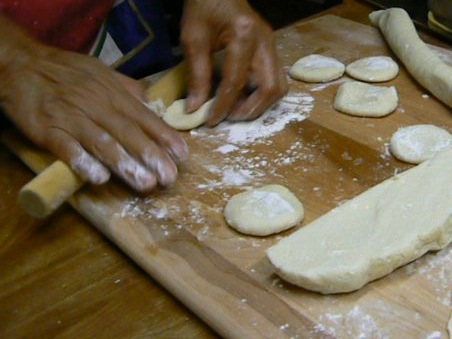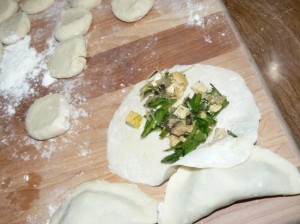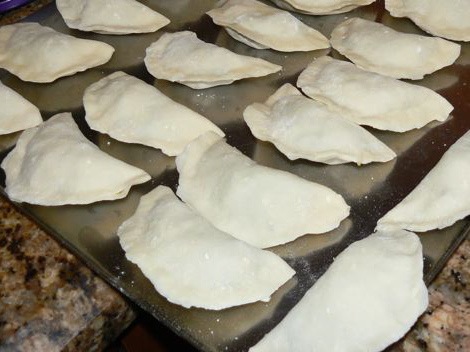This is how the real chinese grandmas do it. We are home to California for the summer, and this is the kind of food my mom makes on a daily basis. Handmade dumplings, which are just not found anywhere but in a real Chinese grandma kitchen.
The key to handmade dumplings is the dough. Mom takes a wide stainless mixing bowl of flour and adds water with a dash of salt (she never measures). She mixes with chopsticks until the center is sticky but plenty of flour left around the perimeter. Then holding the bowl rim and occasionally rotating the bowl with her left hand, she kneads the dough with her right hand, mopping up the remaining flour. She covers the smooth ovalish oblong with a damp cloth and leaves it to rest in the mixing bowl while she makes the filling.
Mom chops fresh chives from her garden along with other precooked filling elements: dried black mushrooms (rehydrated by a brief boil in water), glass noodles (also rehydrated), eggs (cooked into flat omelet), tofu (which Mom also likes to cook briefly in boiling water) and handful of tiny dried shrimp (a Chinese specialty).
My dad has machine-like precision and speed rolling the dumpling wrappers. Mom cuts the oblong of dough, shapes long thin rolls and snaps off identical marshmallow-sized pieces from each. Using a thin rolling pin that he made in classic DIY engineer fashion from a cut-up broomstick handle, my dad swiftly flattens each piece into the size of a medium pancake with the thinness of a crepe. He makes perfect circles that are slightly thicker in the center and thinnest at the far edges. This gives the wrapper more strength in the center to hold the filling while leaving an edge around the half-moon dumpling – the part that gets a double layer of dough when the dumpling is folded – that is not overly doughy. Dad does this by rolling with one hand from the center of the dough outward, and using the other hand to rotate the dough at each roll. Center out, turn, center out, turn. In a few seconds, a perfect dumpling wrapper.
Meanwhile Mom spoons filling into the center of the round (actually uses chopsticks), then folds far end of the wrapper up and seals the dumpling by pinching the edges between her thumb and forefinger. One by one, she fills a flour-sprinkled cookie sheet with a tidy line-up of dumplings.
Mom pan fries batch after batch using an electric frying pan with a domed lid that she purchased 30 years ago – so old the temperature readings on the dial have long been worn away. She likes the even heat and how the domed lid gives room for steam, a key element in the cooking. A thin coat of corn oil goes into the heated pan. Then dumplings are laid in, close but not touching. Lid on. A few minutes later, after the dumplings are starting to form a crisp brown crust beneath – lid up, and in goes a half-cup of water – not directly on the dumplings. Lid back on. The water immediately sizzles to steam, and the hot steam cooks the tops and insides of the dumplings. A few minutes again, then Mom lifts out the dumplings by spatula and turns them over on the plate, brown crust up to keep it crisp. Served and immediately eaten – first bites taken carefully, as steam inside bursts out – dipped in a simple tangy sauce of soy sauce and white vinegar.









Oh my goodness! I’ve actually had the pleaseure of eating the food of this “Chinese Grandma”… The amount of flavor should be illegal! Her duplings are unmatched and “Chinese Mom’s” fried rice?! FORGET ABOUT IT!! Homemade definately makes a world of difference in flavoring… Personally, I think the secret ingrediant is LOVE! 🙂 (CORNY BUT TRUE!)
Agreed! I confess to hovering near the kitchen table and inconspicuously (hopefully) taking more than perhaps my fair share.
This is the 2nd occasion I have come across your blog post in the last couple weeks. Seems like I ought to take note of it.
I had to comment as I found your site tonight. This is my favorite food! My mom makes her gyoza (not sure what you’d call it) the same way. She makes them and freezes the extras just in case for me. She made dozens of packages when I was pregnant (which I ate almost every night as a snack). They definitely aren’t as good as fresh, but good enough. I can almost taste the onigiris, crispy gyoza, and my giant bowl of vinegar with a touch of soy. YUM!
Oh! Actually, my mom’s gyozas touch each other in rows. Must be some sort of japanese thing. I’m wondering if it would be better if they didn’t touch. It would be crispier. I’ll ask her to try it next time. 🙂
hee, don’t tell your mom how to make her gyoza! you might get in trouble. =P
Where can I find the recipe for these yummy looking dumplings?
sadie – excellent question! those are my mom’s expert handiwork, and i keep meaning to post the recipe. honestly i don’t make them myself – i would love to but they are time consuming – and in general i try to post very achievable food here that anyone can make. but i love the heritage recipes, and i think people (myself included) would love to know what goes into handmade dumplings, even if they may not attempt them on their own.